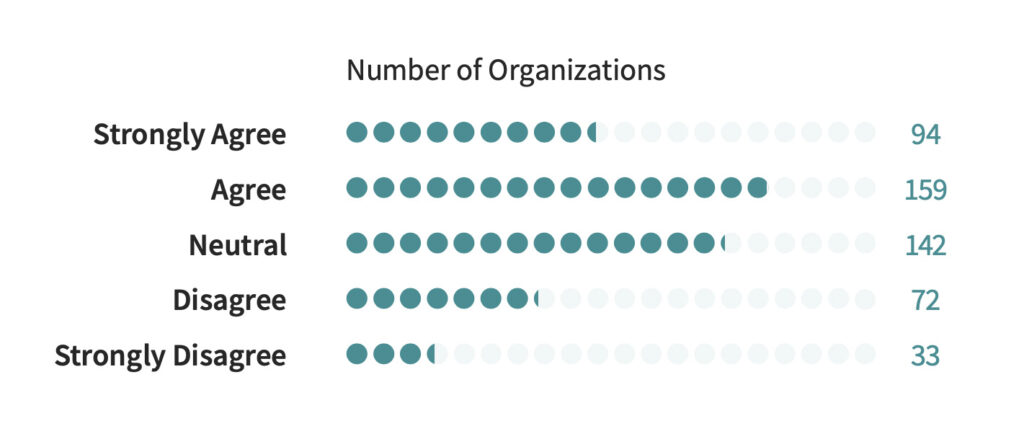Since 2021, the conversation around museums has come abuzz with a new watchword: hybridity. It’s an idea that emerged at the tail-end of lockdowns, as cultural organizations began considering ways to merge their pandemic-era digital programs with that of in-person participation. The hybrid or phygital experience, then, presented a solution for meeting both onsite and online demand, while ensuring a museum’s offerings could live on more than one platform.
But what exactly does a hybrid museum experience look like? Cuseum has sought to find out in its two-part report, The State of Virtual & Hybrid Offerings at Cultural Organizations. It surveys 500 cultural professionals on how their institutions have approached the phygital landscape, forefronting the many routes into blending digital and physical. According to its topline findings, 70 percent of respondents said they serve “at least some” exclusively virtual visitors, highlighting the potential to reach and convert audiences beyond museums’ four walls. Conversely, there also lie opportunities to deepen in-person engagement using digital tools.
“By introducing digital offerings throughout the visitor experience, museums have an opportunity to initiate an engagement loop,” reads the report, “wherein both onsite and online experiences play off of each other to supercharge audience activation.” Here, then, are some key points from the first part of the report on what it means to offer a hybrid museum experience from pre to post-visit.
The virtual push

Using their virtual platforms, museums can help drive footfall by offering a preview or tease of its onsite offerings, as the Asian Art Museum has done with its regular Virtual Preview Showcase sessions. Image: Asian Art Museum
The past two years have brought forth many a way into deepening and monetizing digital engagement, but can virtual programs and platforms now help urge in-person attendance? The report says yes. For one, online ticketing has long been an essential tool for cultural organizations to drive onsite visits — 27 percent of survey respondents note that the majority of their tickets are sold online.
But as well, a museum could use its virtual presence to preview or tease its physical offerings. This has been explored by organizations including the California Academy of the Sciences, which furnishes online previews of its exhibitions, and the Asian Art Museum, with its regular Virtual Preview Showcase that gathers its curators to discuss upcoming shows.
The personalized visit

The TMW ToGo app allows users to build and tailor their own museum tours. Image: TMW
Cultural organizations can further build out the above pre-visit encouragement by inviting audiences to personalize their upcoming museum experiences. These digital planning tools have taken the form of the Henry Ford Museum’s My Must-Sees online guide and the National Gallery Singapore’s Art Journey feature.
Personalization can also enhance onsite visits, namely with wayfinding: the TMW ToGo app by the Vienna Museum of Science and Technology, for instance, enables visitors to tailor tours, which are then led by a virtual guide.
Indeed, digital technologies continue to play roles during in-person visits. Much has been written on this platform about the use of AR, VR, and immersive elements to boost onsite programs; Cuseum’s report further surfaces how QR codes, placed throughout a museum or its galleries, can unlock for visitors more information, while encouraging them to sign up to a mailing list for updates or share their experience on social media.
The post-visit conversion

Cuseum’s survey found that the majority (51 percent) of respondents agreed or strongly agreed that continued tech investment to enhance digital and hybrid engagement should be a priority for their institutions. Image: Cuseum
Engagement doesn’t end when a visitor leaves a museum. In fact, as Cuseum found, a number of cultural organizations already engage in follow-ups with guests post-visit, sending personalized emails (often using data collected during the online ticketing process) to survey their experience, promote upcoming programs, or sell memberships. Such post-visit outreach was particularly useful for the National Aquarium, which reportedly signed up 500 new members through its automated email campaigns.
Rather than simply platforming the same content online and onsite, hybrid offerings mean bridging the physical and digital to create the aforementioned “engagement loop.” Digital tools could drive and augment the physical journey, and the physical experience could fuel digital engagement. It’s a recalibrated approach duly summed up by the Metropolitan Museum of Art’s Tricia Robson: “What happens if you’re outside in the world and want to come to the museum or what if you’re starting at the museum and want to continue that experience?”



